Visit to Tikal
Thanks to Kelly Piercy, the local Port Officer of the Ocean Cruising Club, an excursion was arranged to visit the Mayan ruins at Tikal. Tikal happened to be at the top of our list of places to visit during our time in Guatemala, and we weren't disappointed.
A total of 23 of us departed Fronteras at about 9am on 26 September. Kelly had arranged to pick everyone up from their individual marinas in his lancha (rigid wooden dinghy) so that we didn't have to leave our own ribs and dinghies at the town dock. Things started out well, but on his last run to pick up passengers from RAM marina, Kelly's outboard stopped working and refused to start again. After a quick call to Hugo, a local lancha driver, Kelly's lancha was towed to the town dock, with all remaining passengers shared between the two lanchas.

Kelly's lancha being towed

Group photo...everybody smile!
Our bus journey took us to hotel La Casa Don David on the shores of Lago Peten Itza in El Remate, where we would spend two nights. We arrived at the hotel at approximately 2.30pm and immediately enjoyed the comfort of our air conditioned bedroom, and took a shower after the long and hot ride. El Remate is famous for its wood carvings and whilst there, we visited a working wood carving studio.

Wood carver explaining some of the carvings

Selection of carvings


Wood carving in progress
Later that afternoon we took a short bus trip to the nearby island town of Flores to watch the sunset, and have a bite to eat before returning to El Remate. Sadly, this being rainy season, we didn't get to experience one of the famous sunsets that are usually seen from the Sky Bar in Flores. Never mind, we all got to enjoy some Happy Hour cocktails instead.

Sky Bar

Street scene in Flores


Cocktail in the Sky Bar

Waiting for the sunset, sipping cocktails

Lemonade and ice, very refreshing

Not the sunset we hoped for, but nice anyway
Our departure time the following morning to go to Tikal was 5am, so on arrival back at El Remate, we retired for an early night.
Our guide, Oliver, met us bright and early at the hotel and accompanied us on the short bus ride from the hotel to the Tikal National Park. He navigated us through jungle paths to the many ruins, and pointed out local flora and fauna along the way.
Tikal is the ruins of an ancient Mayan city which was discovered in 1853, but excavation work did not begin until the 1950's. In 1979, it was declared a UNESCO World Heritage Site. It is one of the most interesting and enjoyable of the Mayan sites to visit, largely due to its remoteness, but also its jungle setting. The park is approximately 570 square kilometres and the city of Tikal covered an area greater than 16 square kilometres, which included 3,000 structures. Only a fraction of these structures have been uncovered, in what was the centre of the city. Sadly, due to lack of funds, it is unlikely that more temples will be uncovered anytime soon.
The ancient city of Tikal is set on a low hill, surrounded by low-lying swampy ground. One of the reasons the Mayans may have settled here is due to the abundant fertile upland soils, and the abundance of flint. The wealth of this valuable stone meant they were able to build good tools, and the flint could be traded for other goods. Tikal had no water other than what was collected from rainwater and stored in reservoirs. It is believed the site was inhabited from the 6th century BC to the 9th century AD.
The architecture of the city was built from limestone and includes the remains of temples that tower over 70 metres high, large royal palaces, in addition to a number of smaller pyramids, palaces, residences, administrative buildings, platforms and inscribed stone monuments. The limestone was quarried onsite. The depressions formed by the extraction of the limestone were plastered to waterproof them and were used as reservoirs. The main plazas in the city were surfaced with stucco and laid to a gradient that channelled rainfall into a system of canals that fed the reservoirs.
It is believed that one of the reasons that led to the Mayans eventually abandoning the site in the mid 900's AD was due to over population, deforestation, erosion and nutrient loss.
At the heart of the city is the Gran Plaza. It is flanked on the east and west sides by two great temple-pyramids. On the north side it is bordered by the North Acropolis and on the south side by the Central Acropolis.

Ocellated Turkey

Close up of Ocellated Turkey

Keel-billed Toucan

Walking through one of the many jungle paths
The Ceiba Tree is not only Guatemala's National Tree, but it is the sacred tree of the Maya. Some species can grow to 70m or more and have a straight, largely branchless trunk with a huge spreading canopy and buttress roots that can be taller than a grown person. For the Maya, the tree represents the axis mundi, the stable world centre. It constitutes a symbolic vertical line. The line of balance that unites the three realms of the underworld, the earth and the heavens. It is considered a 'Tree of Life' by the Maya. The axis mundi is the 'navel of the world' and is an important symbol to both Guatemala and the Maya.
The Ceiba tree below is thought to be over 100 years old.
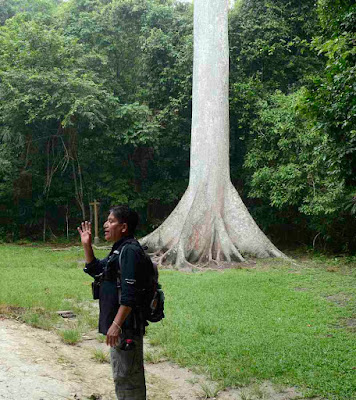
Guide Oliver in front of a large Ceiba Tree

Golden Silk Orb Weaver Spider


Taking a short rest out of the sun

Templo I (Temple I) is known as the Templo del Gran Jaguar (Temple of the Grand Jaguar). It was built to bury and honour King Ah Cacao (King Chocolate). The temple was erected above his tomb and the King's rich burial goods included stingray spines, which were used for blood-letting, 180 jade objects and 90 pieces of bone carved with hieroglyphs. At the top of the 44m temple is a funerary shrine. The roof comb that crowned the temple was originally adorned with reliefs and bright paint.

Temple I


Our guide demonstrating the amazing acoustics between the temples
Templo II (Temple II) is located on the west side of the Gran Plaza. It was built by King Ah Cacao in honour of his wife. It is the most thoroughly restored of the major temples at Tikal. We were able to climb to the top of the temple via a set of wooden steps erected around the back of the temple, to protect the temple from damage. Two badly eroded giant masks adorn the upper platform and give the temple its other name of The Temple of Masks. The roof comb is highly ornate and bears the sculpture of a face with circular ear spools.

Temple II

External steps to the top of Temple II
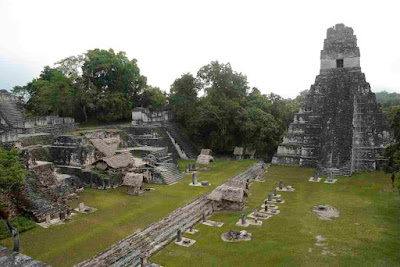
Looking across the Plaza to Temple 1


Platform around the top of Temple II with Temple I in the distance
Templo IV (Temple IV) is a Mesoamerican pyramid. It was one of the tallest buildings in the Maya World. The pyramid is 64.6 metres high and rises way above the jungle canopy, affording spectacular views over the whole site and had a part to play in a famous film. In “Star Wars Episode IV: A New Hope”, Luke, Hans Solo and crew land the Millennium Falcon on Yavin 4, a jungle covered moon. It’s from here that the heroes launch their attack on the Death Star.
Once again, we were able to climb to the top of this structure, thanks to a set of wooden steps erected nine years ago up one side of the pyramid. From here, you can clearly see the tops of other structures also poking through the jungle canopy. Despite it being an overcast day with lots of cloud cover, the sight was still breath taking.

Taking a break to enjoy the view from the top of Temple IV

View from the top of Temple IV


A few of the group enjoying the view

Tikal Crab Spider

A well disguised cricket

Tiger ant close up
Below are some more photos taken around the vast site.
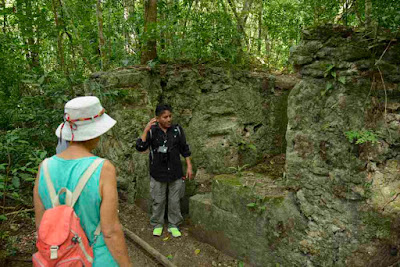
Oliver our guide explaining the significance of another ruin

Wish you could hear all the jungle sounds

Temple showing repaired excavations at the front

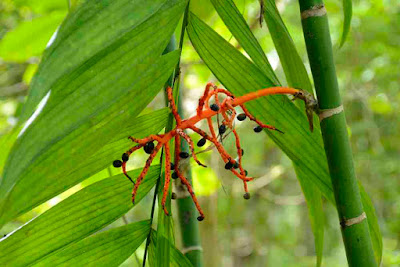





Temple V is the most recently excavated Temple and stands at 187 feet high. It is actually a mortuary pyramid of an as yet unknown ruler.

Temple IV

Our guide explaining the Mayan Calendar

Monkey relaxing in a tree

Geoffroy's Spider Monkey

Spider Monkey swinging in the trees above our heads




Below are copies of some of the artefacts found at the site in the museum by the entrance to the park.

For a dazzling smile insert Jade

Stunning replica, the real one is in Guatemala City

One of the many souvenir stalls in the park
Some water birds in a pond which also houses three crocodiles, who were too shy to be seen the day we visited.


Northern Jacana Wading Bird
After our fascinating day at Tikal, we took a wander around the town of El Remate, where we found wild pigs roaming free along the road and on the lake shore.


At the back of the hotel

Outside the front of the hotel
The hotel has various bird feeders to attract the local birds, and we were lucky enough to see lots of hummingbirds.

So cute

The flash on the camera came in useful
The hotel also has a large Ceiba tree in the grounds. According to the owner, the tree was planted on 1 January 2000 by his ex gardener who was of Mayan descent. As there was widespread panic at the time that the world was going to end as the Millennium approached, the gardener planted the tree to protect them. At only 17 years old, the tree is already immense in size and a real focal point for visitors. That evening, we were treated to a fire show around the tree.

17 year old Cieba tree
After a hearty breakfast on our last day, we boarded the coach back to the Rio Dulce, making a stop at Finca Ixobel for lunch.

Entrance to Finca Ixobel
Finca Ixobel is an ecological resort amongst pine forests and patches of jungle. The grounds contain a natural pond, and some of our group dived in for a refreshing dip before lunch.

Beautiful Setting

No guns or knives inside the bar

Thankfully no alligators
It was a truly wonderful few days, and we look forward visiting Chichen Itza in Mexico next year to see the Mayan temples there.
For now it is back to Tijax and marina life. We do have another exciting excursion coming up, a five day trip to include a visit to the city of Antigua, Lake Atitlan and attend the famous Sumpango Kite Festival. Our trip coincides with Dia de los Muertos (the day of the dead) which we will explain more about in the blog entry for the trip.
Work has started on removing the old teak deck, which is very exciting, and we have downloaded a free cruising guide for the places we hope to visit next year. Our Panama Canal transit still seems a long way off, but we are determined to head South in 2019. In the meantime, we are continuing to love every minute of our stay in the Rio Dulce.
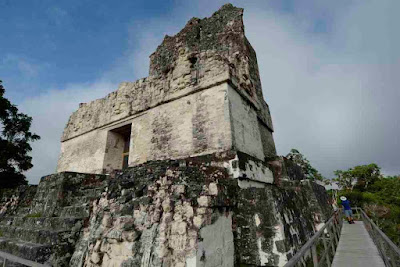

Looked like a lovely trip, and your pictures are excellent. Love the spiders and other creatures.!
ReplyDeleteKeep enjoying: Heather and Tony